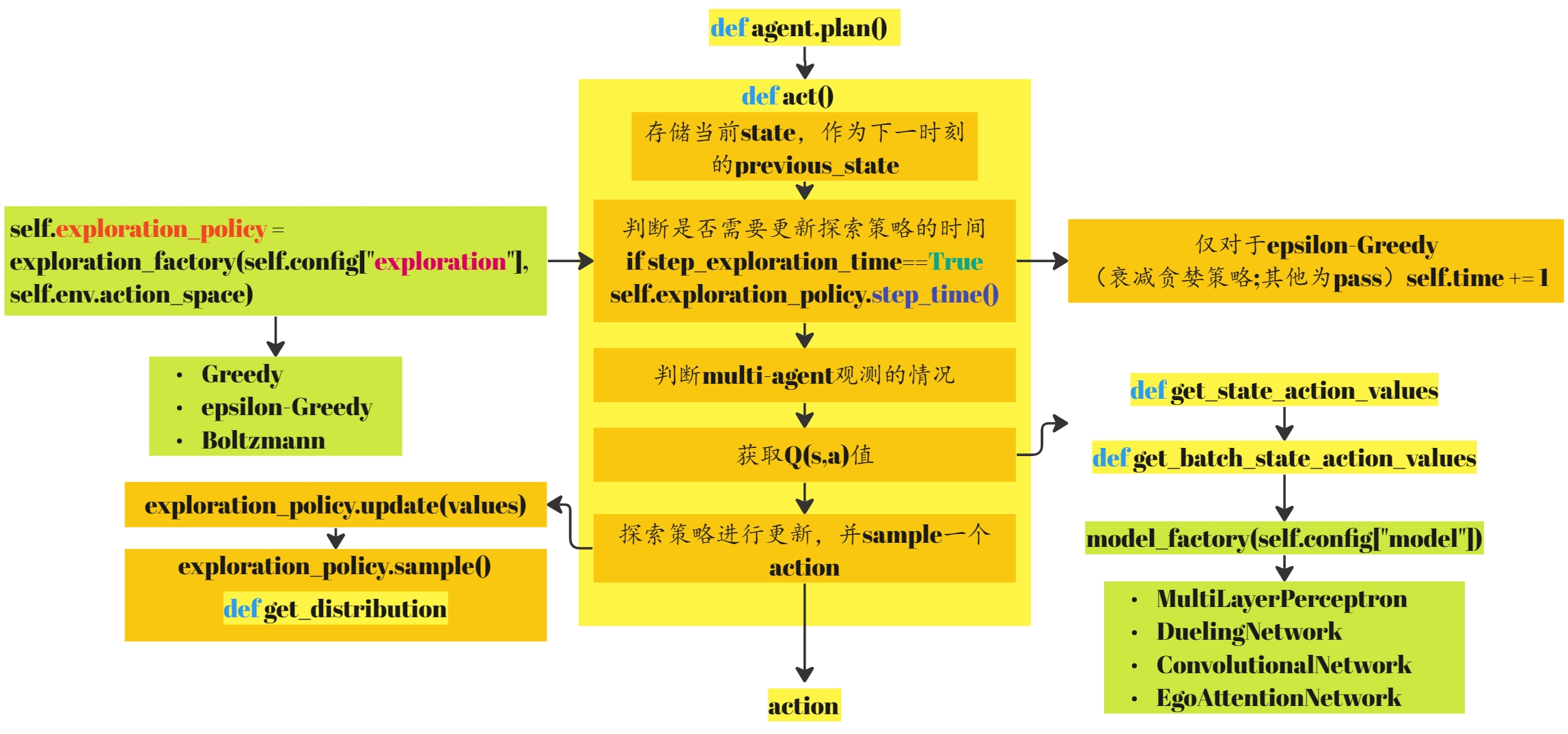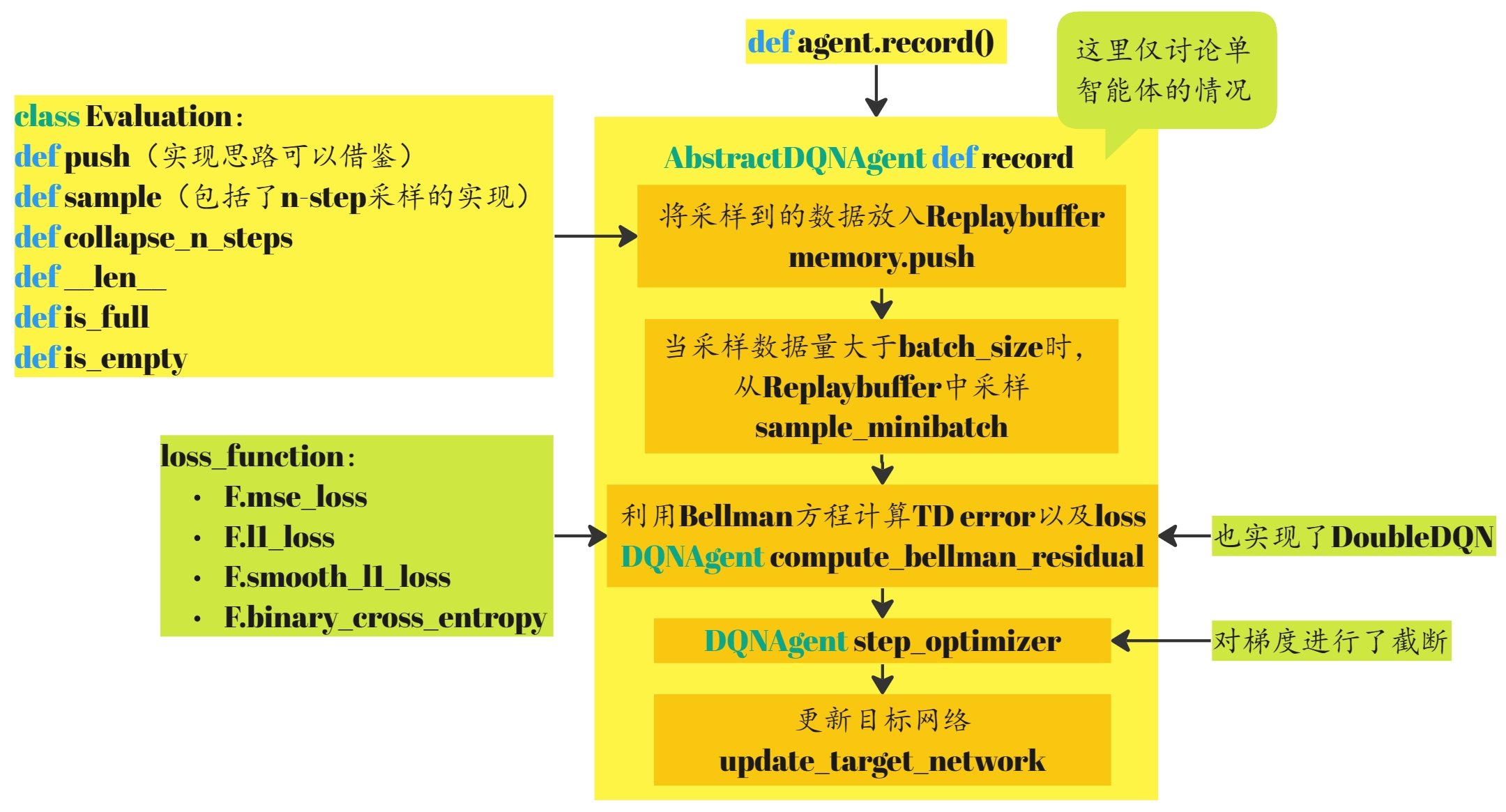文章目录
- Highway-env Intersection
- rl-agents之DQN
- *Implemented variants*:
- *References*:
- Query agent for actions sequence
- 探索策略
- 神经网络实现
- 小结1
- Record the experience
- Replaybuffer
- compute_bellman_residual
- step_optimizer
- update_target_network
- 小结2
- exploration_policy
- Greedy
- ϵ \epsilon ϵ-Greedy
- Boltzmann
- 运行结果
Highway-env Intersection
本文将继续探索rl-agents中相关DQN算法的实现。下面的介绍将会以intersection这个环境为例,首先介绍一下Highway-env中的intersection-v1。Highway-env中相关文档——http://highway-env.farama.org/environments/intersection/。
highway-env中的环境可以通过配置文件进行修改, observations, actions, dynamics 以及rewards等信息都是以字典的形式存储在配置文件中。
PS:DQN、DuelingDQN算法原理可参考【强化学习】10 —— DQN算法【强化学习】11 —— Double DQN算法与Dueling DQN算法
import gymnasium as gym
import pprint
from matplotlib import pyplot as pltenv = gym.make("intersection-v1", render_mode='rgb_array')
pprint.pprint(env.unwrapped.config)
输出config,可以看到如下信息:
{'action': {'dynamical': True,'lateral': True,'longitudinal': True,'steering_range': [-1.0471975511965976, 1.0471975511965976],'type': 'ContinuousAction'},'arrived_reward': 1,'centering_position': [0.5, 0.6],'collision_reward': -5,'controlled_vehicles': 1,'destination': 'o1','duration': 13,'high_speed_reward': 1,'initial_vehicle_count': 10,'manual_control': False,'normalize_reward': False,'observation': {'features': ['presence','x','y','vx','vy','long_off','lat_off','ang_off'],'type': 'Kinematics','vehicles_count': 5},'offroad_terminal': False,'offscreen_rendering': False,'other_vehicles_type': 'highway_env.vehicle.behavior.IDMVehicle','policy_frequency': 1,'real_time_rendering': False,'render_agent': True,'reward_speed_range': [7.0, 9.0],'scaling': 7.15,'screen_height': 600,'screen_width': 600,'show_trajectories': False,'simulation_frequency': 15,'spawn_probability': 0.6}
之后可以通过以下代码输出图像:
plt.imshow(env.render())
plt.show()

输出observation,可以看到是一个5*8的array,:
[[ 1.0000000e+00 9.9999998e-03 1.0000000e+00 0.0000000e+00-1.2500000e-01 6.3297665e+01 0.0000000e+00 0.0000000e+00][ 1.0000000e+00 1.3849856e-01 -1.0000000e+00 -9.9416278e-021.2500000e-01 8.1300293e+01 1.0361128e-15 0.0000000e+00][ 1.0000000e+00 -2.0000000e-02 -1.0000000e+00 0.0000000e+002.2993930e-01 6.5756187e+01 2.8473811e-15 0.0000000e+00][ 0.0000000e+00 0.0000000e+00 0.0000000e+00 0.0000000e+000.0000000e+00 0.0000000e+00 0.0000000e+00 0.0000000e+00][ 0.0000000e+00 0.0000000e+00 0.0000000e+00 0.0000000e+000.0000000e+00 0.0000000e+00 0.0000000e+00 0.0000000e+00]]
observation的解释如下,

通过以下代码,可以将action的类型变为离散的空间。
env.unwrapped.configure({"action": {'longitudinal': True,"type": "DiscreteMetaAction"}
})
rl-agents之DQN
A neural-network model is used to estimate the state-action value function and produce a greedy optimal policy.
Implemented variants:
- Double DQN
- Dueling architecture
- N-step targets
References:
Playing Atari with Deep Reinforcement Learning, Mnih V. et al (2013).
Deep Reinforcement Learning with Double Q-learning, van Hasselt H. et al. (2015).
Dueling Network Architectures for Deep Reinforcement Learning, Wang Z. et al. (2015).
Query agent for actions sequence
由上一节所知,通过调用run_episodes函数,进行具体的agent训练。其中会调用step函数,并执行self.agent.plan(self.observation)。对于DQNAgent的实现,首先由AbstractAgent类实现plan,之后plan函数会调用act函数:
def step(self):"""Plan a sequence of actions according to the agent policy, and step the environment accordingly."""# Query agent for actions sequenceactions = self.agent.plan(self.observation)
// rl_agents/agents/common/abstract.py
class AbstractAgent(Configurable, ABC):def __init__(self, config=None):super(AbstractAgent, self).__init__(config)self.writer = None # Tensorboard writerself.directory = None # Run directory@abstractmethoddef act(self, state):"""Pick an action:param state: s, the current state of the agent:return: a, the action to perform"""raise NotImplementedError()def plan(self, state):"""Plan an optimal trajectory from an initial state.:param state: s, the initial state of the agent:return: [a0, a1, a2...], a sequence of actions to perform"""return [self.act(state)]
DQN抽象类AbstractDQNAgent继承自AbstractStochasticAgent,AbstractStochasticAgent继承自AbstractAgent,在DQN抽象类AbstractDQNAgent中实现对act函数的重写:
def act(self, state, step_exploration_time=True):"""Act according to the state-action value model and an exploration policy:param state: current state:param step_exploration_time: step the exploration schedule:return: an action"""self.previous_state = stateif step_exploration_time:self.exploration_policy.step_time()# Handle multi-agent observations# TODO: it would be more efficient to forward a batch of statesif isinstance(state, tuple):return tuple(self.act(agent_state, step_exploration_time=False) for agent_state in state)# Single-agent settingvalues = self.get_state_action_values(state)self.exploration_policy.update(values)return self.exploration_policy.sample()
探索策略
首先来看一下exploration_policy 的实现:
self.exploration_policy = exploration_factory(self.config["exploration"], self.env.action_space)
探索策略加载的配置文件部分:
"exploration": {"method": "EpsilonGreedy","tau": 15000,"temperature": 1.0,"final_temperature": 0.05
}
跳转到exploration_factory,可以看到主要实现了三类探索策略,具体的内容会在后面部分进行介绍:
- Greedy
- ϵ \epsilon ϵ-Greedy
- Boltzmann
def exploration_factory(exploration_config, action_space):"""Handles creation of exploration policies:param exploration_config: configuration dictionary of the policy, must contain a "method" key:param action_space: the environment action space:return: a new exploration policy"""from rl_agents.agents.common.exploration.boltzmann import Boltzmannfrom rl_agents.agents.common.exploration.epsilon_greedy import EpsilonGreedyfrom rl_agents.agents.common.exploration.greedy import Greedyif exploration_config['method'] == 'Greedy':return Greedy(action_space, exploration_config)elif exploration_config['method'] == 'EpsilonGreedy':return EpsilonGreedy(action_space, exploration_config)elif exploration_config['method'] == 'Boltzmann':return Boltzmann(action_space, exploration_config)else:raise ValueError("Unknown exploration method")
神经网络实现
接着获取 Q ( s , a ) Q(s,a) Q(s,a)值
def get_state_action_values(self, state):""":param state: s, an environment state:return: [Q(a1,s), ..., Q(an,s)] the array of its action-values for each actions"""return self.get_batch_state_action_values([state])[0]
调用了抽象方法get_batch_state_action_values
@abstractmethoddef get_batch_state_action_values(self, states):"""Get the state-action values of several states:param states: [s1; ...; sN] an array of states:return: values:[[Q11, ..., Q1n]; ...] the array of all action values for each state"""raise NotImplementedError
接着来看DQNAgent中的具体实现:
class DQNAgent(AbstractDQNAgent):def __init__(self, env, config=None):super(DQNAgent, self).__init__(env, config)size_model_config(self.env, self.config["model"])self.value_net = model_factory(self.config["model"])self.target_net = model_factory(self.config["model"])self.target_net.load_state_dict(self.value_net.state_dict())self.target_net.eval()logger.debug("Number of trainable parameters: {}".format(trainable_parameters(self.value_net)))self.device = choose_device(self.config["device"])self.value_net.to(self.device)self.target_net.to(self.device)self.loss_function = loss_function_factory(self.config["loss_function"])self.optimizer = optimizer_factory(self.config["optimizer"]["type"],self.value_net.parameters(),**self.config["optimizer"])self.steps = 0def get_batch_state_action_values(self, states):return self.value_net(torch.tensor(states, dtype=torch.float).to(self.device)).data.cpu().numpy()
value_net的实现依赖于model_factory,其中的配置文件部分如下:
"model": {"type": "MultiLayerPerceptron","layers": [128, 128]},
再进入model_factory,主要实现了四类网络:
- MultiLayerPerceptron
- DuelingNetwork
- ConvolutionalNetwork
- EgoAttentionNetwork
这里我们暂且先分析多层感知机MultiLayerPerceptron(即普通DQN)。
// rl_agents/agents/common/models.py
def model_factory(config: dict) -> nn.Module:if config["type"] == "MultiLayerPerceptron":return MultiLayerPerceptron(config)elif config["type"] == "DuelingNetwork":return DuelingNetwork(config)elif config["type"] == "ConvolutionalNetwork":return ConvolutionalNetwork(config)elif config["type"] == "EgoAttentionNetwork":return EgoAttentionNetwork(config)else:raise ValueError("Unknown model type")
MultiLayerPerceptron类继承自BaseModule,BaseModule继承自torch.nn.Module。根据配置文件baseline.json,可以看到MultiLayerPerceptron类的sizes为[128, 128],激活函数为RELU。我们可以注意到,网络实现中有reshape操作,因为state的输入是5*8的矩阵,通过reshape,可以将其转换为一维的向量。最终网络结构类似于下图。

class MultiLayerPerceptron(BaseModule, Configurable):def __init__(self, config):super().__init__()Configurable.__init__(self, config)sizes = [self.config["in"]] + self.config["layers"] self.activation = activation_factory(self.config["activation"])layers_list = [nn.Linear(sizes[i], sizes[i + 1]) for i in range(len(sizes) - 1)]self.layers = nn.ModuleList(layers_list)if self.config.get("out", None):self.predict = nn.Linear(sizes[-1], self.config["out"])@classmethoddef default_config(cls):return {"in": None,"layers": [64, 64],"activation": "RELU","reshape": "True","out": None}def forward(self, x):if self.config["reshape"]:x = x.reshape(x.shape[0], -1) # We expect a batch of vectorsfor layer in self.layers:x = self.activation(layer(x))if self.config.get("out", None):x = self.predict(x)return x
获取 Q Q Q之后,探索策略进行更新,并sample一个action。以 ϵ \epsilon ϵ-Greedy为例,因为 ϵ \epsilon ϵ-Greedy继承DiscreteDistribution,所以主要关注DiscreteDistribution中的相关实现。
def act(self, state, step_exploration_time=True):...self.exploration_policy.update(values)return self.exploration_policy.sample()
rl_agents/agents/common/exploration/epsilon_greedy.pydef update(self, values):"""Update the action distribution parameters:param values: the state-action values:param step_time: whether to update epsilon schedule"""self.optimal_action = np.argmax(values)self.epsilon = self.config['final_temperature'] + \(self.config['temperature'] - self.config['final_temperature']) * \np.exp(- self.time / self.config['tau'])if self.writer:self.writer.add_scalar('exploration/epsilon', self.epsilon, self.time)
class DiscreteDistribution(Configurable, ABC):def __init__(self, config=None, **kwargs):super(DiscreteDistribution, self).__init__(config)self.np_random = None@abstractmethoddef get_distribution(self):""":return: a distribution over actions {action:probability}"""raise NotImplementedError()def sample(self):""":return: an action sampled from the distribution"""distribution = self.get_distribution()return self.np_random.choice(list(distribution.keys()), 1, p=np.array(list(distribution.values())))[0]
可以看到首先需要获得action的一个分布,这部分在 ϵ \epsilon ϵ-Greedy中的实现为:
def get_distribution(self):distribution = {action: self.epsilon / self.action_space.n for action in range(self.action_space.n)}distribution[self.optimal_action] += 1 - self.epsilonreturn distribution
get_distribution 函数返回一个动作的概率分布字典。字典的键是动作,字典的值是动作被选择的概率。概率分布的计算方式为:每个动作都有一个基础概率 self.epsilon / self.action_space.n,其中 self.action_space.n 是动作的总数,即每个动作被选择的概率相等,这是基于探索的角度。同时,最优动作 self.optimal_action 会额外获得一个概率增量 1 - self.epsilon,这是基于利用的角度,即利用已知的最优动作。
sample 函数根据 get_distribution 函数得到的动作概率分布进行采样,返回一个动作。具体地,使用 np_random.choice 函数,其参数包括动作列表和对应的动作概率分布列表,返回的是一个根据给定概率分布随机采样的动作。
小结1
到此,act函数返回一个待执行的action,此部分的框图如下所示:

之后这几步在上一讲已经讨论过http://t.csdnimg.cn/ddpVJ。
# Forward the actions to the environment viewertry:self.env.unwrapped.viewer.set_agent_action_sequence(actions)except AttributeError:pass# Step the environmentprevious_observation, action = self.observation, actions[0]transition = self.wrapped_env.step(action)self.observation, reward, done, truncated, info = transitionterminal = done or truncated# Call callbackif self.step_callback_fn is not None:self.step_callback_fn(self.episode, self.wrapped_env, self.agent, transition, self.writer)
Record the experience
现在step函数中只剩下这一步,我们再来看这一步的实现。
# Record the experience.try:self.agent.record(previous_observation, action, reward, self.observation, done, info)except NotImplementedError:pass
直接跳转到AbstractDQNAgent类中查看相关实现
def record(self, state, action, reward, next_state, done, info):"""Record a transition by performing a Deep Q-Network iteration- push the transition into memory- sample a minibatch- compute the bellman residual loss over the minibatch- perform one gradient descent step- slowly track the policy network with the target network:param state: a state:param action: an action:param reward: a reward:param next_state: a next state:param done: whether state is terminal"""if not self.training:returnif isinstance(state, tuple) and isinstance(action, tuple): # Multi-agent setting[self.memory.push(agent_state, agent_action, reward, agent_next_state, done, info)for agent_state, agent_action, agent_next_state in zip(state, action, next_state)]else: # Single-agent settingself.memory.push(state, action, reward, next_state, done, info)batch = self.sample_minibatch()if batch:loss, _, _ = self.compute_bellman_residual(batch)self.step_optimizer(loss)self.update_target_network()
Replaybuffer
self.memory是Replaybuffer的一个实现
self.memory = ReplayMemory(self.config)
- push函数的实现可以提升运算速率。
- 在强化学习中,经常需要从经验回放缓存(这里就是
self.memory)中抽样出一批数据来更新模型。而这里的n-step是一个常用的技巧,它表明在预测下一个状态时,不仅仅使用当前的状态和动作,还使用接下来的n-1个状态和动作。当n为1时,这就是常见的单步过渡;当n大于1时,这就是n步采样。
rl_agents/agents/common/memory.py
class ReplayMemory(Configurable):"""Container that stores and samples transitions."""def __init__(self, config=None, transition_type=Transition):super(ReplayMemory, self).__init__(config)self.capacity = int(self.config['memory_capacity'])self.transition_type = transition_typeself.memory = []self.position = 0@classmethoddef default_config(cls):return dict(memory_capacity=10000,n_steps=1,gamma=0.99)def push(self, *args):"""Saves a transition."""if len(self.memory) < self.capacity:self.memory.append(None)self.position = len(self.memory) - 1elif len(self.memory) > self.capacity:self.memory = self.memory[:self.capacity]# Faster than append and popself.memory[self.position] = self.transition_type(*args)self.position = (self.position + 1) % self.capacitydef sample(self, batch_size, collapsed=True):"""Sample a batch of transitions.If n_steps is greater than one, the batch will be composed of lists of successive transitions.:param batch_size: size of the batch:param collapsed: whether successive transitions must be collapsed into one n-step transition.:return: the sampled batch"""# TODO: use agent's np_random for seedingif self.config["n_steps"] == 1:# Directly sample transitionsreturn random.sample(self.memory, batch_size)else:# Sample initial transition indexesindexes = random.sample(range(len(self.memory)), batch_size)# Get the batch of n-consecutive-transitions starting from sampled indexesall_transitions = [self.memory[i:i+self.config["n_steps"]] for i in indexes]# Collapse transitionsreturn map(self.collapse_n_steps, all_transitions) if collapsed else all_transitionsdef collapse_n_steps(self, transitions):"""Collapse n transitions <s,a,r,s',t> of a trajectory into one transition <s0, a0, Sum(r_i), sp, tp>.We start from the initial state, perform the first action, and then the return estimate is formed byaccumulating the discounted rewards along the trajectory until a terminal state or the end of thetrajectory is reached.:param transitions: A list of n successive transitions:return: The corresponding n-step transition"""state, action, cumulated_reward, next_state, done, info = transitions[0]discount = 1for transition in transitions[1:]:if done:breakelse:_, _, reward, next_state, done, info = transitiondiscount *= self.config['gamma']cumulated_reward += discount*rewardreturn state, action, cumulated_reward, next_state, done, infodef __len__(self):return len(self.memory)def is_full(self):return len(self.memory) == self.capacitydef is_empty(self):return len(self.memory) == 0
回到record代码中,首先将采样到的数据放入Replaybuffer,当采样数据量大于batch_size时,从Replaybuffer中采样。
def sample_minibatch(self):if len(self.memory) < self.config["batch_size"]:return Nonetransitions = self.memory.sample(self.config["batch_size"])return Transition(*zip(*transitions))
compute_bellman_residual
之后便利用bellman方程进行更新:
loss, _, _ = self.compute_bellman_residual(batch)
def compute_bellman_residual(self, batch, target_state_action_value=None):# Compute concatenate the batch elementsif not isinstance(batch.state, torch.Tensor):# logger.info("Casting the batch to torch.tensor")state = torch.cat(tuple(torch.tensor([batch.state], dtype=torch.float))).to(self.device)action = torch.tensor(batch.action, dtype=torch.long).to(self.device)reward = torch.tensor(batch.reward, dtype=torch.float).to(self.device)next_state = torch.cat(tuple(torch.tensor([batch.next_state], dtype=torch.float))).to(self.device)terminal = torch.tensor(batch.terminal, dtype=torch.bool).to(self.device)batch = Transition(state, action, reward, next_state, terminal, batch.info)# Compute Q(s_t, a) - the model computes Q(s_t), then we select the# columns of actions takenstate_action_values = self.value_net(batch.state)state_action_values = state_action_values.gather(1, batch.action.unsqueeze(1)).squeeze(1)if target_state_action_value is None:with torch.no_grad():# Compute V(s_{t+1}) for all next states.next_state_values = torch.zeros(batch.reward.shape).to(self.device)if self.config["double"]:# Double Q-learning: pick best actions from policy network_, best_actions = self.value_net(batch.next_state).max(1)# Double Q-learning: estimate action values from target networkbest_values = self.target_net(batch.next_state).gather(1, best_actions.unsqueeze(1)).squeeze(1)else:best_values, _ = self.target_net(batch.next_state).max(1)next_state_values[~batch.terminal] = best_values[~batch.terminal]# Compute the expected Q valuestarget_state_action_value = batch.reward + self.config["gamma"] * next_state_values# Compute lossloss = self.loss_function(state_action_values, target_state_action_value)return loss, target_state_action_value, batch
with torch.no_grad():用于禁止在其作用域内进行梯度计算- 实现了DoubleDQN
self.loss_function = loss_function_factory(self.config["loss_function"])loss函数包括以下几种:
def loss_function_factory(loss_function):if loss_function == "l2":return F.mse_losselif loss_function == "l1":return F.l1_losselif loss_function == "smooth_l1":return F.smooth_l1_losselif loss_function == "bce":return F.binary_cross_entropyelse:raise ValueError("Unknown loss function : {}".format(loss_function))
step_optimizer
对梯度进行了截断
def step_optimizer(self, loss):# Optimize the modelself.optimizer.zero_grad()loss.backward()for param in self.value_net.parameters():param.grad.data.clamp_(-1, 1)self.optimizer.step()
update_target_network
更新目标网络
def update_target_network(self):self.steps += 1if self.steps % self.config["target_update"] == 0:self.target_net.load_state_dict(self.value_net.state_dict())
小结2
到此,整个DQN算法实现完毕,record部分的框图如下:

exploration_policy
这部分主要实现了三种策略:
- Greedy
- ϵ \epsilon ϵ-Greedy
- Boltzmann
此部分可以参考:【强化学习】02—— 探索与利用
Greedy
Greedy贪婪策略即选择最优的策略 a t = arg max a ∈ A Q ( s , a ) a_t=\argmax_{a\in\mathcal{A}}Q(s,a) at=argmaxa∈AQ(s,a)
class Greedy(DiscreteDistribution):"""Always use the optimal action"""def __init__(self, action_space, config=None):super(Greedy, self).__init__(config)self.action_space = action_spaceif isinstance(self.action_space, spaces.Tuple):self.action_space = self.action_space.spaces[0]if not isinstance(self.action_space, spaces.Discrete):raise TypeError("The action space should be discrete")self.values = Noneself.seed()def get_distribution(self):optimal_action = np.argmax(self.values)return {action: 1 if action == optimal_action else 0 for action in range(self.action_space.n)}def update(self, values):self.values = values
ϵ \epsilon ϵ-Greedy
ϵ \epsilon ϵ-Greedy公式如下:
a t = { arg max a ∈ A Q ^ ( a ) , 采样概率:1- ϵ 从 A 中随机选择 , 采样概率: ϵ a_t=\begin{cases}\arg\max_{a\in\mathcal{A}}\hat{Q}(a),&\text{采样概率:1-}\epsilon\\\text{从 }\mathcal{A}\text{ 中随机选择},&\text{采样概率: }\epsilon&\end{cases} at={argmaxa∈AQ^(a),从 A 中随机选择,采样概率:1-ϵ采样概率: ϵ
这里实现的其实是衰减贪心策略,衰减曲线如下图所示。
ϵ = final-temperature + ( temperature − final-temperature ) ∗ e − t τ \begin{aligned}\epsilon &= \text{final-temperature}+(\text{temperature}-\text{final-temperature})*e^{\frac{-t}{\tau}}\end{aligned} ϵ=final-temperature+(temperature−final-temperature)∗eτ−t

class EpsilonGreedy(DiscreteDistribution):"""Uniform distribution with probability epsilon, and optimal action with probability 1-epsilon"""def __init__(self, action_space, config=None):super(EpsilonGreedy, self).__init__(config)self.action_space = action_spaceif isinstance(self.action_space, spaces.Tuple):self.action_space = self.action_space.spaces[0]if not isinstance(self.action_space, spaces.Discrete):raise TypeError("The action space should be discrete")self.config['final_temperature'] = min(self.config['temperature'], self.config['final_temperature'])self.optimal_action = Noneself.epsilon = 0self.time = 0self.writer = Noneself.seed()@classmethoddef default_config(cls):return dict(temperature=1.0,final_temperature=0.1,tau=5000)def get_distribution(self):distribution = {action: self.epsilon / self.action_space.n for action in range(self.action_space.n)}distribution[self.optimal_action] += 1 - self.epsilonreturn distributiondef update(self, values):"""Update the action distribution parameters:param values: the state-action values:param step_time: whether to update epsilon schedule"""self.optimal_action = np.argmax(values)self.epsilon = self.config['final_temperature'] + \(self.config['temperature'] - self.config['final_temperature']) * \np.exp(- self.time / self.config['tau'])if self.writer:self.writer.add_scalar('exploration/epsilon', self.epsilon, self.time)def step_time(self):self.time += 1def set_time(self, time):self.time = timedef set_writer(self, writer):self.writer = writer
Boltzmann
玻尔兹曼分布(Boltzmann Distribution)是描述分子在热力学平衡时分布的概率分布函数。它表明在给定的能量状态下,不同的微观状态出现的概率是不同的,且符合一个指数函数形式。
在热力学中,任何物质在一定温度下都会具有一定的热运动,这些热运动状态可以用分子内能或动能来描述。而玻尔兹曼分布表明了在相同温度下,分子在所有可能状态之间的分布概率。其表达式为:
P ( E i ) = e − E i / k T ∑ j e − E j / k T P(E_i) = \frac{e^{-E_i/kT}}{\sum_{j} e^{-E_j/kT}} P(Ei)=∑je−Ej/kTe−Ei/kT
其中, P ( E i ) P(E_i) P(Ei)为分子处于能量状态 E i E_i Ei的概率, k k k为玻尔兹曼常数, T T T为温度, E j E_j Ej为所有可以达到的能量状态。
可以看到,玻尔兹曼分布中每个能量状态的出现概率与其能量成负指数关系,因此能量较小的状态出现的概率更大。这符合熵增加的趋势,即越有序的状态出现的概率越小。
class Boltzmann(DiscreteDistribution):"""Uniform distribution with probability epsilon, and optimal action with probability 1-epsilon"""def __init__(self, action_space, config=None):super(Boltzmann, self).__init__(config)self.action_space = action_spaceif not isinstance(self.action_space, spaces.Discrete):raise TypeError("The action space should be discrete")self.values = Noneself.seed()@classmethoddef default_config(cls):return dict(temperature=0.5)def get_distribution(self):actions = range(self.action_space.n)if self.config['temperature'] > 0:weights = np.exp(self.values / self.config['temperature'])else:weights = np.zeros((len(actions),))weights[np.argmax(self.values)] = 1return {action: weights[action] / np.sum(weights) for action in actions}def update(self, values):self.values = values运行结果
运行命令与方法在上一讲已经介绍【rl-agents代码学习】01——总体框架。
超参数设置采用默认设置,使用DQN算法分别运行4000steps和20000steps。使用Tensorboard查看结果:
tensorboard --logdir C:\Users\16413\Desktop\rl-agents-master\scripts\out\IntersectionEnv\DQNAgent\baseline_20231113-123234_7944\
4000steps


可以看到最后的episode reward大致在3左右。
20000steps

可以看到最后的episode reward大致在3左右。



| 解方程 齐次性 非齐次性 扩充问题)
)


主副控智能自动断电桌面PDU插排)






)




